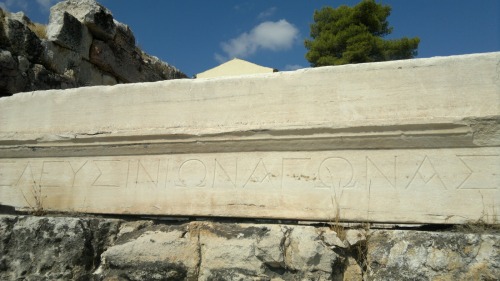hellenismo:“It is celebrated there (in Eleusis), the agon in honor of Kore and Demeter, which
hellenismo:“It is celebrated there (in Eleusis), the agon in honor of Kore and Demeter, which is called Eleusinia; the prize consists of barley grains…this is the first agon ever celebrated. In fact, after Demeter found the fruit of strength, men made show of it and performed in this competition…” (Schol. Pind. Ol. 150a/b) The oldest agones, along with those celebrated during the Panathenaia- the Parian marble assigns their foundation to the reign of Pandion, the son of Kekrops. Most probably, they were celebrated from the 15th day until the 18th day of Metageitnion, and were open to all the Hellenes, and were, of course, in honor of the Eleusinian Goddesses; as a scholar has written in a very appropriate way: “These contests were honored as the oldest in the whole of Hellas and in their sacred character they embodied the most venerable and enduring of all the sacred centers of Hellenes.” With regard to dating, an inscription puts them among the Panathenaia and the 12th day of Boedromion; this period of Metageitnion is then perfect, even as the whole month is sacred to Demeter (due also to the beginning of the Sacred Truce for the Great Mysteries of Boedromion). These celebrations sanction the end of the harvest period and then are a thanksgiving to the Two Goddesses for Their gifts (αγεται δε εν Αθηναις μετα <την> των Δημητριακων καρπων συλλογην τηι Δημητρι ευχαριστηρια), the collection of grain and other summer fruits, and then they are celebrated in late summer; some ancient non- Athenian authors confused them with the Mysteries, but ‘Tà Eleusinia’ never indicates the Mysteries of Boedromion in the Attic inscriptions, in particular an inscription speaks very clearly of sacred heralds with the duty to “announce the Panathenaia, the Eleusinia and the Mysteries. “(IG II2 1496. 130; Pi. O. 9150, Ps. Aristot. Peplos, F 637 Rose, Arist. Pan. Eleus.) There are two Eleusinia, as for the Panathenaia: Megala and Mikra. The Megala are a penteteris, they take place the second year of the Olympiad (IG II2 947 the Mikra instead fall in the first and third year of the Olympiad (IG II2 1028, 1496, 2336) - probably the latter, following a reform of the calendar in the third century, became annual. Both have a general procession, a procession of the youths, and a sacrifice on their part of oxen. It seems certain that they were held at Eleusis, being there present a stadium, a race track and also a theater (all these are now lost due to the modern factories…). Fragments of an Athenian calendar recall precisely enough the Gods honored during these festivities and the offerings, as well as the officiating priests: “for Themis, a sheep; for Zeus Herkeios, a sheep; for Demeter, a sheep; for Pherrephatte, a ram; for Eumolpus, a sheep; for Melichos the Hero [sheep?]; for Archegetes [sheep?]; for Polyxenus [sheep?]; for Threptos (Demophon?), a chosen ovine; for Dioklos, [a sheep?]; for Celeus, [a sheep?]; the Eumolpidai sacrifice them; for the priestess of Demeter, apometra, 100 drachmas …. a pig (for a purification?). For Hestia, [a sheep?]; for Athena, a sheep; for the Graces [?]; for Hermes Enagonios [?], [for Heracles, a sheep?]; for [?]; [sheep?]; … for the priestess of Athena Polias, apometra, [30, 70, or 120 drachmas]. ” A sacred law from Eleusis bears instead a slightly different list of sacrifices: for Gaia, Hermes Enagonios and the Graces, a she-goat; for Poseidon, a ram; for Artemis, a goat; for Telesidromus and Triptolemus, one ram; for Pluto and Dolichos and the Two Goddesses a triple sacrifice- trittoa boarchos. (IG II2 1672; IG II2 1496.130; IG II2 1028.15; IG II2 2336.208; IG II2 1706; IG I2 5; IG II2 930; IG II2 3554) As we know from several sources, they mainly included running races, in particular the stadion and the race in arms (IG I3 991, Pind. O. 9.150; Iscr.agon.gr. 88.13), but we also know of other competitions: pancratium, pentathlon at the Megala, diaulos and horse racing at the Megala, dolichos, boxing and chariot race, and even a musical competition and a race horse at the Megala (added by Lycurgus), plus an ‘ancestral competition’. A list of expenditures for the celebrations informs us that the competitions were essentially the same, but at the Megala the prizes were most valuable; a report drawn up by the treasurers of Eleusis remembered uses of the wheat grown in the sacred plain of Rharos: among those mentioned, there are also the medimnai awarded to the winners at the Eleusinian competitions (70 to the winners of the Mikra, and 260 to those of the Megala). (SEG XVI, 55; IG II2 1672; Iscr.Cos EV 203; I.Didyma 201.18; Milet I.9 369.B.8; I.Iasos 108.5; Pind. O. 9.99, O. 13.110, I. 1.57; Arist. Ath, Pol. 54.7; Ael. Ar. Panath. 13. 189; IG I2 5) -- source link
Tumblr Blog : hellenismo.tumblr.com

